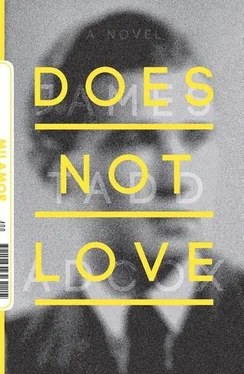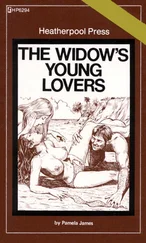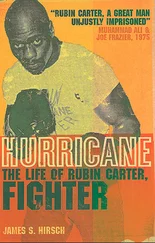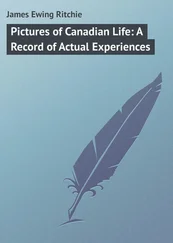“Don’t mock me,” he says.
“I wasn’t mocking you.”
“What you were doing with your face. It was mocking me.”
“What, this?” Viola starts, but then sees his expression and thinks better of it. “Why don’t you show me how you’d really do it, then?” she says, pulling him towards her.
“Why are youreally here?” Viola asks the FBI agent. They are lying under the pale green sheets.
“I’m really here to spy on you, personally. We have determined that you represent one of the primary threats to our national security.”
“Knew it,” Viola says.
“The present administration recognizes that sadness runs counter to our way of life,” the FBI agent says. “And yet you keep insisting on being sad.”
Viola turns away from him to face the wall. “I already said I’m over it. How many times do I have to tell you? Besides, that doesn’t make any sense, insisting on being sad. I don’t insist on anything.”
Robert returns fromhis vacation in Italy with a small image of Catherine of Alexandria, patron saint of archivists, librarians, and apologists, which had been blessed by the new pope. “It’s very pretty,” Viola says, rubbing her finger over the image in its gold locket.
Viola looks up St. Catherine in a new edition of the Lives of the Saints , Dewey Decimal classification 120, Theology. Catherine’s fame centers on her attempted conversion of the Emperor Maxentius, who, in response, first tortured and imprisoned her, then, when Catherine remained steadfast in her faith, attempted to marry her. The virgin Catherine of course replied that she was betrothed to Christ, an answer that so enraged Maxentius that he tortured her again, this time with a giant spiked wheel. The wheel miraculously flew apart in response to Catherine’s prayers, at which point Maxentius decided to behead her. Modern scholars note that the earliest accounts of Catherine’s life date to five hundred years after her death, and that there is little to no evidence of her existence as a historic personage. In addition to librarians, archivists, and apologists, the Lives notes that she is patron to “millers, potters, spinners, knife-sharpeners, and other persons who work with a wheel.” She is often represented in paintings as a scholar.
Viola looks at the ways her body has stretched from the last several pregnancies. There is a spiderweb of stretch marks across her hips and stomach. If this were for something, she thinks. If this were a sign of something tangible. I can imagine looking down at my body and being proud of what it has done. Holding my child and looking down at the signs of my strong body. But all it has done is spit out failure.
Other times she thinks: This is what I have survived. That itself is worth being proud of.
Does the FBI agent find this sexy, she thinks. Of course he’s noticed. You can’t not notice. How does he interpret these marks on her body? Is it a thing for him? A fetish? She doesn’t like the idea of it being a fetish, though she’s not entirely sure why. What ultimately is the difference between a fetish and simply being attracted to something that other people aren’t?
Robert of course loves her too much for her to ever get the truth out of him.
Viola’s talk therapisthas new plants. They look better than the old plants. Warmer, somehow. Viola tries to remember if the old plants were fake, and can’t.
“I didn’t think I was settling, with Robert,” Viola says to the talk therapist. “I thought that there were certain things about the relationship that I was very excited about, and other things that I was less excited about but thought that I could live with. Isn’t that true of every relationship?”
“Do you think it’s significant that you keep avoiding discussing your miscarriage?”
“Miscarriages,” Viola says. “Three. And how long could I possibly talk about them?”
Viola’s talk therapist recommends that she start keeping lists of things that she’s grateful for. Viola writes down: Apples. Newly-fallen leaves. The smell of crayons. Bright colors. Internet videos of kittens and other small animals. She looks at her list and thinks, Saccharine. She tears the list out of the spiral-bound notebook she had been writing in and throws it away. She writes, at the top of a fresh sheet of paper: Things That I Am Grateful For. She stares at the sheet for a long time. It occurs to her that the exercise is designed to be saccharine, that the whole idea is to make her a more saccharine and thus more socially-acceptable person.
Viola has bruises on her body but won’t tell Robert where they are from. According to the internet it’s possible that she’s bruising because she’s not getting enough iron.
Robert goes to the grocery store and looks at the iron supplements. In the grocery store he reads a story about how a certain fungus can get into an ant’s brain and take control of its entire motor system, thus causing the ant to act in ways going against the ant’s self-interest. He buys a small bottle of iron supplements and the magazine with the story about the ants.
Robert calls his grandmother from the grocery store parking lot and asks about her salt, whether she’s getting enough of it.
“Robert, it is always so good to hear your voice. How long has it been since you called?”
On the radio during the drive home a reporter talks about the most recent shooting downtown. This is number four.
Robert and Violadiscuss the nature of love.
“There are stages,” Robert says. “The first stage is infatuation. It is primarily chemical in nature. It is perfectly natural, after a time, for this stage to fade.”
“I could fall back in love with you,” Viola says. “That is an option.”
“How would you do that?”
“I don’t know,” Viola says. “I suppose it would just have to happen.” They are sitting at the kitchen table, eating breakfast. Robert is eating oatmeal with almonds and molasses, and Viola is eating two pieces of toast.
“Are your concerns primarily sexual in nature? Do you need new adventures? Do you feel as though you are stagnating?”
“Is anything primarily sexual in nature?”
“Though you wouldn’t deny that there have been issues.”
“The purpose of love,” Viola says, “from an evolutionary standpoint, is to keep two people together long enough to raise a kid. Of course, there are some pretty compelling arguments for why one should take evolutionary psychology with a grain of salt.”
“It’s not my fault that we haven’t been able to have a kid.”
“Whose fault is it?”
“It’s nobody’s fault. Why does there need to be fault?”
“One of our bodies has had to put up with this,” Viola says. “This constant failure.”
“Is that what this is about?”
“I don’t know what it’s about.”
Viola takes her plate to the sink to rinse it. She thinks: When we were first married, I thought that you were a well of stability, in which I could drown.
Viola places her plate in the dishwasher. She says, “There’s no reason why two adults who get along reasonably well can’t cohabitate, regardless of whether they are actively in love.”
“Is that what you want?” Robert says. “Cohabitation?”
“The current scientific consensus is that love is not a single feeling, but a related cluster of feelings. Though we assume love to be unquestionably a good, studies have found that people in love spend more time sad, or angry, or in other forms of emotional distress than people not in love.”
Читать дальше




![Jakob Wassermann - Issue Does Not Exist],errors:{](/books/585068/jakob-wassermann-issue-does-not-exist-errors-thumb.webp)







